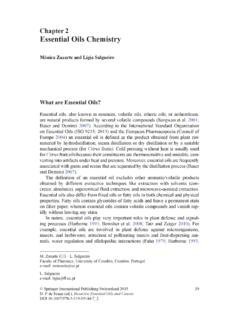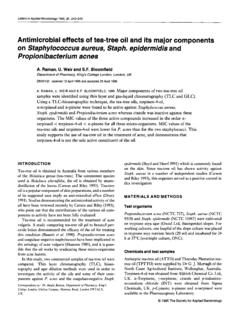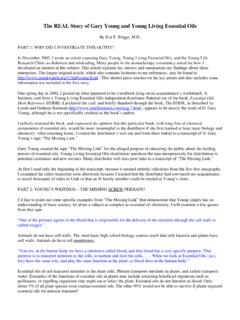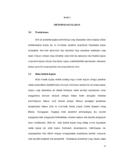Transcription of Antibacterial activity of Thymus vulgaris essential …
1 NUSANTARA BIOSCIENCE ISSN: 2087-3948 Vol. 4, No. 2, Pp. 50-56 E-ISSN: 2087-3956 July 2012 DOI: Antibacterial activity of Thymus vulgaris essential oil alone and in combination with other essential oils KATERYNA KON1, , MAHENDRA RAI2 1 Department of Microbiology, Virology, and Immunology, Kharkiv National Medical University, 61022, Pr. Lenina, 4, Kharkiv, Ukraine. Tel. +380507174771, e-mail: 2 Department of Biotechnology, Sant Gadge Baba Amravati University, Amravati-444602, Maharashtra India Manuscript received: 16 July 2012. Revision accepted: 31 July 2012. Abstract. Kon K, Rai M. 2012. Antibacterial activity of Thymus vulgaris essential oil alone and in combination with other essential oils. Nusantara Bioscience 4: 50-56. essential oils (EOs) from plants represent an alternative approach in combating antibiotic-resistant bacteria.
2 One of the EOs with proven Antibacterial properties is Thymus vulgaris EO. The purpose of the present work was to investigate in vitro Antibacterial activity of T. vulgaris EO alone and in combination with other EOs. The activity of T. vulgaris EO was screened in combination with 34 EOs against Staphylococcus aureus and Escherichia coli by disk diffusion method; then the most effective combinations were evaluated by broth microdilution method. Against S. aureus the synergistic effect was found in combination of T. vulgaris and Cinnamomum zeylanicum EOs with fractional inhibitory concentration (FIC) index of ; Juniperus communis and Picea abies EOs showed additive effect (FIC indexes were and , respectively). Combination of T. vulgaris EO with Aniba rosaeodora and Melissa officinalis EOs demonstrated synergistic effect against E.
3 Coli (FIC indexes were and , respectively); combination of T. vulgaris and Mentha piperita EOs was additive (FIC index ). Therefore, combining T. vulgaris EO with other EOs has potential in further enhancing its Antibacterial properties. Key words: Thymus vulgaris , essential oils, combinations, Staphylococcus aureus, Escherichia coli. Abstrak. Kon K, Rai M. 2012. Aktivitas antibakteri minyak atsiri Thymus vulgaris tunggal atau campuran dengan minyak atsiri lain. Bioscience Nusantara 4: 50-56. Minyak atsiri tumbuhan merupakan senyawa alternatif untuk melawan bakteri resisten antibiotik. Salah satu minyak atsiri yang terbukti bersifat antibakteri adalah minyak atsiri Thymus vulgaris . Penelitian ini bertujuan untuk mengetahui aktivitas in vitro antibakteri minyak atsiri T. vulgaris tunggal atau campuran dengan minyak atsiri lain.
4 Aktivitas antibakteri minyak atsiri T. vulgaris dan campurannya dengan 34 minyak atsiri lain terhadap Staphylococcus aureus dan Escherichia coli ditapis dengan metode cawan difusi, kemudian campuran yang paling efektif diuji dengan metode mikrodilusi kaldu. Efek sinergis terhadap S. aureus ditemukan pada campuran antara minyak atsiri T. vulgaris dan Cinnamomum zeylanicum dengan indeks konsentrasi hambat fraksional (FIC) 0,26; minyak atsiri Juniperus communis dan Picea abies menunjukkan efek aditif (indeks FIC masing-masing adalah 0,74 dan 0,78). Campuran minyak atsiri T. vulgaris dengan Aniba rosaeodora dan Melissa officinalis menunjukkan efek sinergis terhadap E. coli (indeks FIC masing-masing adalah 0,23 dan 0,34); campuran minyak atsiri T. vulgaris dengan Mentha piperita menunjukkan efek aditif (indeks FIC 0,55).
5 Oleh karena itu, campuran minyak atsiri T. vulgaris dengan minyak atsiri lainnya memiliki potensi untuk meningkatkan sifat antibakteri. Kata kunci: Timus vulgaris , minyak atsiri, kombinasi, Staphylococcus aureus, Escherichia coli INTRODUCTION Wide spread of antibiotic resistance remains a serious clinical problem, which stimulates studies for search of new methods for coping with drug resistance or renews interest in traditionally used and forgotten methods, such as treatment with Antibacterial plant extracts and essential oils (EOs) (R os and Recio 2005; Fisher and Phillips 2009). Combined therapy is traditionally used to increase antimicrobial activity and reduce toxic effects of agents (Houghton 2009). Thyme plant is used since ancient times to achieve healing, antiseptic fumigator, food preservation and other useful effects (Stahl-Biskup and S ez 2002).
6 Nowadays, Thymus vulgaris EO belongs to EOs with the most pronounced antimicrobial activity (Iten et al. 2009). It was shown to be active against many bacteria, viruses and fungi. High antimicrobial activity of thyme oil and its components, first of all thymol and carvacrol, was demonstrated against Staphylococcus aureus (Al-Bayati 2008; Sokovi et al. 2010; Levi et al. 2011), including methicillin-resistant isolates (Tohidpour et al. 2010), S. epidermidis (Sokovi et al. 2010), Enterococcus faecalis (Levi et al. 2011), Bacillus cereus (Al-Bayati 2008), Vibrio cholerae (Rattanachaikunsopon and Phumkhachorn 2010), Escherichia coli (Levi et al. 2011), Proteus mirabilis (Sokovi et al. 2010; Levi et al.)
7 2011), P. vulgaris (Al-Bayati 2008), Pseudomonas aeruginosa (Sokovi et al. 2010), Salmonella enteritidis (Sokovi et al. 2010), S. choleraesuis (Levi et al. 2011), S. typhimurium KON & RAI Antibacterial activity of Thymus vulgaris essential oil 51(Sokovi et al. 2010), and other microorganisms. In spite of many studies devoted to thyme oil, its combinations with other EOs have not been paid much attention. Gutierrez et al. (2009) studied combinations composed of thyme and oregano EOs against B. cereus, E. coli, Listeria monocytogenes and P. aeruginosa by checkerboard method and found that thyme-oregano EO combination had additive effect against B. cereus and P. aeruginosa, and indifferent effect against E. coli and L. monocytogenes.
8 Furthermore, against L. monocytogenes the authors studied five more thyme EO combinations with basil, lemon balm, marjoram, rosemary, and sage EOs. The results showed that basil, rosemary and sage EOs with thyme oil had additive effect, while lemon balm and marjoram EOs were indifferent. The analysis of available literature shows that EO combinations, including combinations with thyme EO, represent perspective approach in antimicrobial treatment and prevention, however, in contrast to combinations of traditional antibiotics, this topic is not still well studied and requires further investigations. The main goal of the present study was to investigate antimicrobial activity of thyme EO in combination with different EOs against S. aureus and E.
9 Coli. MATERIALS AND METHODS essential oils. We used commercial EO of Thymus vulgaris (purchased from NPF Zarstvo Aromatov, Sudak, Ukraine) and 34 different EOs (purchased from Aroma Inter, Mykolaiv, Ukraine; Aromatika, Kiyiv, Ukraine; NPF Zarstvo Aromatov, Sudak, Ukraine) (Table 1). Strains, preparation of inocula. We used reference strains Staphylococcus aureus (ATCC 25923) and Escherichia coli (ATCC 25922). The cultures of bacteria were maintained in meat peptone agar slants at 4 C throughout the study and used as stock cultures. For preparation of inocula, cultures were grown until logarithmic phase, and then bacterial density was adjusted to approximately 108 colony forming units (CFU) per mL for disk diffusion method and 105 CFU/mL for microdilution method with sterile saline solution.
10 Bacterial counts were confirmed by plating out on meat-peptone agar, plates were incubated at 37 C for 24 h. Disk diffusion method. This method was used for the screening of EOs for increase of Antibacterial activity in the presence of thyme oil. Bacterial suspension was spread over the plates 85 mm in diameter containing Mueller-Hinton agar using a sterile cotton swab in three directions in order to get a uniform microbial growth. Under aseptic conditions empty sterile disks were impregnated with 5 l of EO. Disks were left for 5 min at room temperature for better oil absorption and were then placed on inoculated agar surface. A standard disc with ciprofloxacin (10 g/disc) was used as a reference control. The Petri dishes were left for 30 min at room temperature (20-22 C) for better oil diffusion and were then placed to an incubator at 37 C for 24 h.








